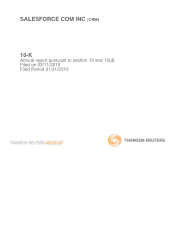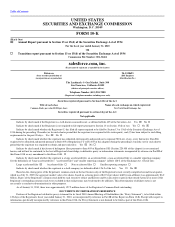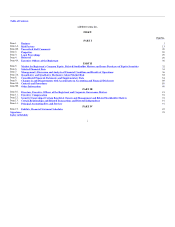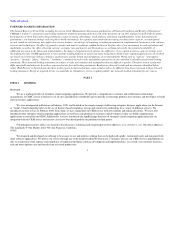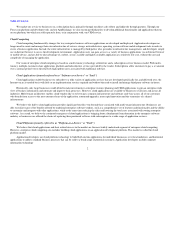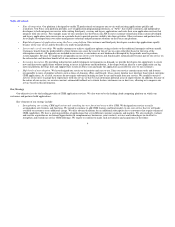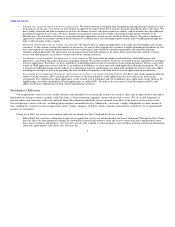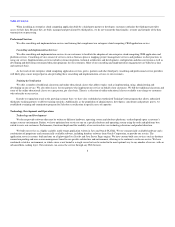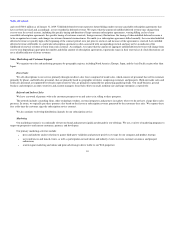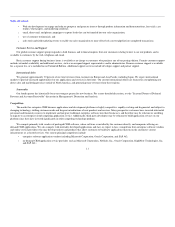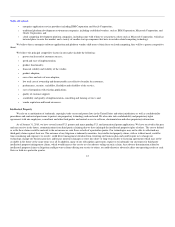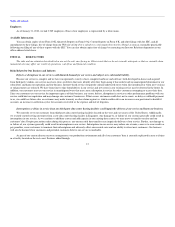Salesforce.com 2009 Annual Report Download - page 6
Download and view the complete annual report
Please find page 6 of the 2009 Salesforce.com annual report below. You can navigate through the pages in the report by either clicking on the pages listed below, or by using the keyword search tool below to find specific information within the annual report.
Table of Contents
("IT") departments that typically develop applications for a company's internal use and independent software vendors ("ISVs") that develop applications to
sell to customers. Traditionally, these developers have needed to purchase, install, test and maintain complex software and hardware infrastructure to develop
and deliver their applications. This requirement resulted in more time and resources being spent maintaining infrastructure and less time and resources being
available to actually develop applications, with a resulting reduction in innovation and productivity levels.
Cloud platforms enable corporate IT developers and ISVs to leverage the benefits of a multi-tenant platform for developing new applications. Cloud
platforms allow developers to build applications with a browser and an Internet connection, just as cloud applications allow users to use applications through a
browser. In addition, developers typically pay no upfront costs when building cloud applications, with costs only to be incurred at the point of application
deployment.
Our Solution
Our CRM applications help companies better record, track, manage, analyze and share information regarding sales, customer service and support, and
marketing operations. Our Force.com cloud computing platform, which was introduced in 2007, allows customers and partners to more extensively customize
and integrate our applications or build entirely new cloud applications beyond CRM without having to invest in new software, hardware and related
infrastructure. These newly developed applications, which are hosted and run on our infrastructure, can then be used for internal operations or sold to third
parties. We also offer the AppExchange, an online directory for cloud applications, where customers can browse, test-drive and deploy applications from
salesforce.com and our partners. Since we introduced the AppExchange directory in 2006, more than 800 applications developed mostly by our partners have
been posted to the directory.
Substantially all of our subscription and support revenue comes from subscriptions to our core CRM application services, all of which include the
customization benefits of the Force.com platform. In order for customers to install and run custom applications, whether built by themselves or by our
partners, they must be a subscriber to our service.
By subscribing to our service, our customers do not have to make large and potentially risky upfront investments in software, hardware, implementation
services and IT staff as they would with traditional software solutions. We believe that our service enables businesses to rapidly achieve the benefits of higher
productivity, and lower their total cost of ownership for their business application.
Key advantages of our solution include:
• Secure, scalable and reliable delivery platform. The delivery platform for our service has been designed to provide our customers with high
levels of performance, reliability, and security. We have built, and continue to invest in, a comprehensive security infrastructure, including
firewalls, intrusion detection systems, and encryption for transmissions over the Internet, which we monitor and test on a regular basis. In
addition, all of our customers' data is replicated in near real-time to help protect the data and ensure service continuity in the event of a major
disaster. We built and maintain a multi-tenant application architecture that has been designed to enable our service to scale securely, reliably, and
cost-effectively. Our multi-tenant application architecture maintains the integrity and separation of customer data while still permitting all
customers to use the same application functionality simultaneously. Our architecture also enables customers to segment access privileges across
their user base.
• Rapid deployment. Our service can be deployed rapidly since our customers do not have to spend time procuring, installing or maintaining the
servers, storage, networking equipment, security products, or other infrastructure hardware and software necessary to ensure a scalable and
reliable service. We also offer consulting, training services, and online resources to assist customers in rapidly deploying and optimizing their use
of our service.
3

